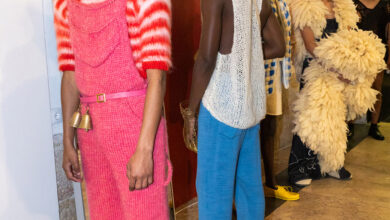FashionZoot reports
RECONNECTING WITH THE PAST: THE PRINGLE ARCHIVE PROJECT S/S 2012
Pringle of Scotland presented the next installment of its long-term collaboration with Central Saint Martins during the Pitti trade fair.
Text by Anna Battista
Founded by Robert Pringle in 1815 in Hawick, in the Scottish Borders, Pringle of Scotland, first started as a manufacturer of hosiery and underwear. Knitting cashmere since the 1870s, producing knitwear as outerwear, launching iconic intarsia designs such as the famous argyle pattern and introducing the twinset, the company soon turned into one of the first luxury knitwear manufacturers.
In February 2011, Pringle of Scoltand announced a new chapter into its long-term collaboration with London’s Central Saint Martins College of Art and Design with two projects in collaboration with the BA and MA Fashion Course students.
The BA Fashion Course, History and Theory students researched and catalogued the company archive and played host to the first day of record in the Scottish Hawick headquarters in August 2010. Former factory workers attended together with Lesley Rankin, Pringle of Scotland’s first female designer in the 1960s, and Zandra Elliot, a 1950s house model. In that occasion they recorded further anecdotes and, in the following months, MA Fashion Students under the direction of Professor Louise Wilson OBE, designed a collection that, exploring the rich heritage of the 196- year-old company, radically reinvented it.

Working with specialised craftspeople, the students developed designs characterised by fragmented argyle patterns and, breaking the distinctive diagonal checkerboard arrangement, created modern geometries and trompe l’oeil prints.
The designs were showcased last week during Florence’s Pitti trade show and were accompanied by images of the Autumn/Winter 2011-12 campaign shot at Glasgow’s iconic Barroland music venue and featuring Tilda Swinton.
Current Pringle of Scotland creative director Alistair Carr, presented instead his new collection during Milan Menswear Fashion Week. Inspired by early Pringle of Scotland fans such as the Duke of Windsor, who had a passion for the argyle pattern, and actor and socialite Noël Coward, who used to be fond of Pringle’s pink sweaters, Carr injected in the new collection his experience acquired at fashion houses such as Chloé, Marni and Balenciaga coming up with sleeveless knits in bright and bold colours and fitted cashmere sweaters matched with neon-soled footwear designed in collaboration with Puma.
Zoot Magazine: How did the students react to this project?
Louise Wilson: Our students are always enthusiastic. In fact it would be very absurd not being enthusiastic about such projects. The interesting thing for them in this case was getting the chance of working on an extended archive. Alistair O’Neill’s history and theory students from the BA Fashion Course really worked to museum standards. The archive didn’t exist before, but the materials were kept in boxes. When my students came along, the archive had already been transferred on a disc so they could easily go through thousands of images and there was very little researching to do because everything had been pulled together for them.
Zoot Magazine: Did the students find the argyle pattern inspiring?
Louise Wilson: There was no team meeting, but the five students we chose to work on this project all focused on a version of the argyle pattern, because in their mind Pringle owned a pattern that nobody else did. So, apart from the stripy ones, every single sweat here is based on the argyle. Another characteristic of some of the sweaters with prints is that the scale of the print was changed, they tweaked the original motif by using two tones to make the print look smudged and misprinted.
Zoot Magazine: Did the students work in the Hawick-based factory?
Louise Wilson: Yes, they did. So this project wasn’t really a matter of sending the sketch off to a factory and then waiting for the piece to arrive, but they were able to work with the manufacturer’s experts on the weights, experimenting a lot and also refitting the sweaters. This last point is actually very important since, even though the designs seem to have really classic shapes, they have actually all been refitted. I would define this as a “live project” for our students since there was a lot of interaction with the manufacturer plus they got prize money and also royalties on the sales. After all they are professional designers since they have already graduated and some of the people who focused on this project already work for major fashion houses.
Zoot Magazine: Will the project continue in future?
Louise Wilson: Yes it will since this is not a one hit project. We did the Autumn/Winter collection for women and now the Spring/Summer season. We like working with a sponsor on a long-term basis, but this is also a reflection of the quality we offer to the sponsor.
Zoot Magazine: Did you enjoy the Pringle of Scotland installation at the Pitti trade fair?
Louise Wilson: It has been a good installation since it felt more like a gallery and had something to say. So, even though it was about sales, it wasn’t completely sales-driven.













